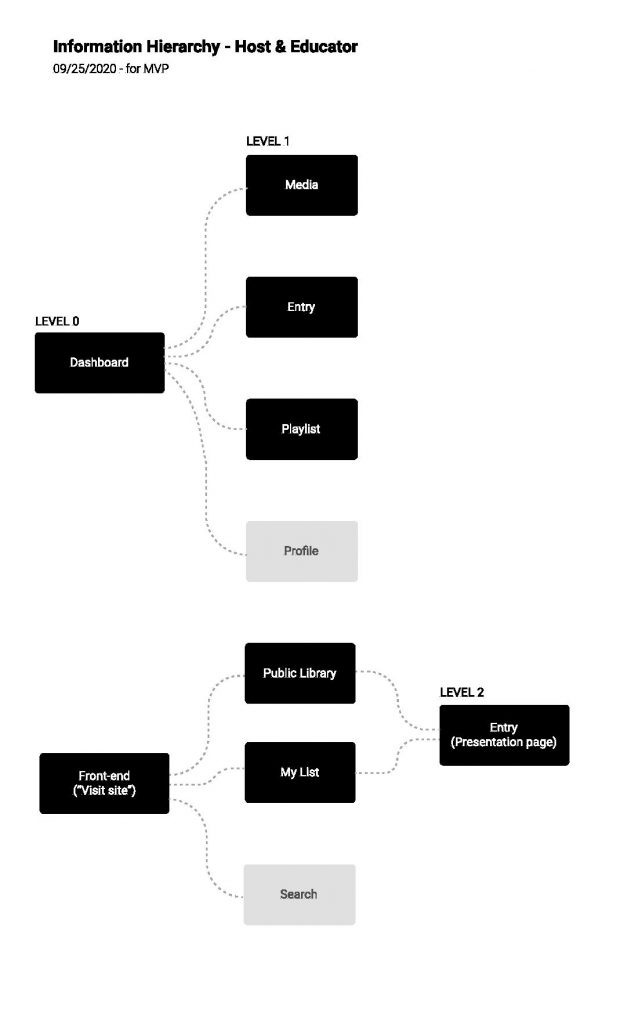Week 5: Playtest plans, the ETC Tour, and MVP
Following the feedback from Quarters, the team made progress towards a few key milestones. Most notably, we began the logistical planning for ETSecrets, a full-featured, production-heavy playtest/demo of what a virtual tour over zoom might look like. Additionally, we also finalized work on ETC-required production materials (i.e. poster design, logo design, half-sheets, and initial website layout).
Programming: Programming continued to make progress towards the MVP. While the summer team’s mockup had assumed several systems and identified some key features, the MVP identified by our team would encapsulate the core systems required to hierarchically organize information into a complete tour (see diagram below). The WordPress dashboard would be doing most of the heavy lifting of a CMS by managing uploaded media, creating entries that group media by topic, and also creating playlists that group entries into guest-centered tours. Following Bryan’s advice, we would continue to avail ourselves of the pre-built WordPress profile/account functionality as opposed to building that from scratch.
Additionally, we began to make a strong distinction between the Dashboard “backend” and the visitor-facing “front-end” that we would have more control over graphically and programmatically. While this might create design/UX issues down the road, this distinction is convenient for this phase of development to get us to playtesting with museum staff sooner. Ideally these systems will be in place for us to use with ETSecrets.

Design: Design moved forward with organizing and designing a tour to take place at the ETC itself. While many participating museums would likely lack the necessary manpower to execute what we had planned, we scoped large to identify pain points early on in the project. Essentially, would most museums want a single staff member sharing a single screen or would they want multiple cameras, multiple staff members, etc? If so, what are the effort requirements for executing the latter experience? ETSecrets would also have its own Eventbrite page in order to test event planning sites (since we likely wouldn’t be building any sort of ecommerce into our tool).
Broad questions that the ETSecrets tour would tackle include the following:
- How much planning is required to plan a virtual tour over zoom with a moving camera?
- How much would a steadicam help alleviate Zoom nausea with a moving camera?
- What role would Eventbrite have in setting guest expectations before the tour?
- How would having an expert guest impact guest experience (i.e. Steve Audia)?
- What role would a Zoom moderator play in an on-site virtual tour?
- How much could we transition between different camera shots?
- How much “secret” or “special” content could we show?
This sort of experience (moving camera through a physical space) was of interest to at least 3 of our Museum partners (Fallingwater, Frick, and Mattress Factory). Westmoreland and AWAACC also expressed some interest but were skeptical given their current programming offerings/curriculum focus.
Beyond ETSecrets, the team also laid out playtesting plans for the semester up to Halves as follows:

- Week 6: ETSecrets scope playtest
- Week 7: Museum 1:1 MVP playtests with each partner institution.
- Week 8: Halves
A packed schedule, but one that will force progress of some sort.
